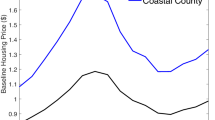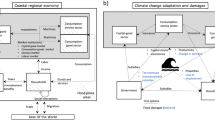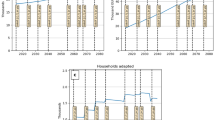Abstract
Barring an unprecedented large-scale effort to raise island elevation, barrier-island communities common along the US East Coast are likely to eventually face inundation of the existing built environment1 on a timescale that depends on uncertain climatic forcing. Between the present and when a combination of sea-level rise and erosion renders these areas uninhabitable, communities must choose levels of defensive expenditures to reduce risks and individual residents must assess whether and when risk levels are unacceptably high to justify investment in housing. We model the dynamics of coastal adaptation as the interplay of underlying climatic risks, collective actions to mitigate those risks, and individual risk assessments based on beliefs in model predictions and processing of past climate events. Efforts linking physical and behavioural models to explore shoreline dynamics2,3,4 have not yet brought together this set of essential factors. We couple a barrier-island model with an agent-based model of real-estate markets5 to show that, relative to people with low belief in model predictions about climate change, informed property owners invest heavily in defensive expenditures in the near term and then abandon coastal real estate at some critical risk threshold that presages a period of significant price volatility.
This is a preview of subscription content, access via your institution
Access options
Subscribe to this journal
Receive 12 print issues and online access
$209.00 per year
only $17.42 per issue
Buy this article
- Purchase on Springer Link
- Instant access to full article PDF
Prices may be subject to local taxes which are calculated during checkout




Similar content being viewed by others
References
Pilkey, O. H. et al. The North Carolina Shore and Its Barrier Islands (Duke Univ. Press, 1998).
Lazarus, E., McNamara, D. E., Gopalakrishnan, S, Smith, M. D. & Murray, A. B. Emergent behavior in a coupled economic and coastline model for beach nourishment. Nonlin. Process. Geophys. 18, 989–999 (2011).
McNamara, D. E., Murray, A. B. & Smith, M. D. Coastal sustainability depends on how economic and coastline responses to climate change affect each other. Geophys. Res. Lett. 38, L07401 (2011).
Michael, J. A. Episodic flooding and the cost of sea-level rise. Ecol. Econ. 63, 149–159 (2007).
West, J. J., Small, M. J. & Dowlatabadi, H. Storms, investor decisions and the economic impacts of sea level rise. Climatic Change 48, 317–342 (2001).
McNamara, D. E. & Werner, B. T. Coupled Barrier Island-Resort Model: 1. Emergent instabilities induced by strong human-landscape interactions. J. Geophys. Res. 113, F01016 (2008).
IPCC Climate Change 2007: The Physical Science Basis (eds Solomon, S. et al.) (Cambridge Univ. Press, 2007).
Zhang, K. Twentieth Century Storm Activity and Sea Level Rise Along the United States Coast and Their Impact on Shoreline Position PhD thesis, Univ. Maryland (1998).
Valverde, H. R., Trembanis, A. C. & Pilkey, O. H. Summary of beach nourishment episodes on the US East Coast barrier islands. J. Coast. Res. 15, 1100–1118 (1999).
Pilkey, O. H. & Dixon, K. L. The Corps And the Shore (Island Press, 1996).
Dean, R. G. Beach Nourishment: Theory and Practice (World Scientific, 2002).
Borick, C. & Rabe, B. Fall 2011 national survey of American public opinion on climate change. Issues Govern. Stud. 45, 1–8 (2012).
Cline, S. Global warming text was removed from Virginia bill on rising sea levels. US News and World Report (13 June 2012).
Siceloff, B. Senate committee likes the slow-rise approach for sea-level forecasts. The Raleigh News and Observer (7 June 2012).
Psuty, N. P. & Ofiara, D. D. Coastal Hazard Management (Rutgers Univ. Press, 2002).
Nicholls, R. J. & Cazenovia, A. Sea-level rise and its impact on coastal zones. Science 328, 1517–1520 (2010).
Dutta, D., Herath, S. & Musiake, K. A mathematical model for flood loss estimation. J. Hydrol. 277, 24–49 (2003).
Acknowledgements
Support for this project was provided by the National Science Foundation (EAR-0952120).
Author information
Authors and Affiliations
Contributions
D.E.M. conceived and designed the study, designed and conducted model experiments, and wrote portions of the manuscript and Supplementary Information. A.K. also conceived and designed the study, provided advice on model experiments, and wrote portions of the manuscript and Supplementary Information.
Corresponding author
Ethics declarations
Competing interests
The authors declare no competing financial interests.
Supplementary information
Supplementary Information
Supplementary Information (PDF 312 kb)
Rights and permissions
About this article
Cite this article
McNamara, D., Keeler, A. A coupled physical and economic model of the response of coastal real estate to climate risk. Nature Clim Change 3, 559–562 (2013). https://doi.org/10.1038/nclimate1826
Received:
Accepted:
Published:
Issue Date:
DOI: https://doi.org/10.1038/nclimate1826
This article is cited by
-
Measuring weather exposure with annual reports
Review of Accounting Studies (2024)
-
Managing retreat for sandy beach areas under sea level rise
Scientific Reports (2023)
-
Assessing coastline recession for adaptation planning: sea level rise versus storm erosion
Scientific Reports (2023)
-
Demonstrating the value of beaches for adaptation to future coastal flood risk
Nature Communications (2023)
-
Sea Level Rise and Home Prices: Evidence from Long Island
The Journal of Real Estate Finance and Economics (2023)



